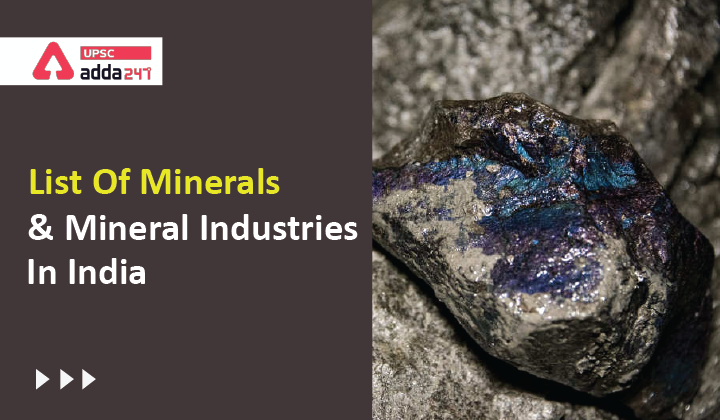Table of Contents
Distribution of minerals in India: Relevance
- GS 1: Distribution of key natural resources across the world
Minerals in India
Due to its varied geological structure, India is endowed with a rich variety of mineral resources. North India, which is covered by alluvial plain tracts are devoid of minerals or economic use. The mineral resources provide the country with the necessary base for industrial development. In this article, we will discuss the location of minerals in India and the development of mineral industries in India since independence. Distribution of minerals in India is a very important topic for UPSC CSE Prelims and you can expect questions from this section every year.
Distribution of Minerals in India
Minerals are generally concentrated in three broad belts in India.
- The North-Eastern Plateau Region: It covers s Chhotanagpur (Jharkhand), Odisha Plateau, West Bengal and parts of Chhattisgarh.
- The South-Western Plateau Region: Karnataka, Goa and contiguous Tamil Nadu uplands and Kerala.
- The North-Western Region: Aravali in Rajasthan and part of Gujarat and minerals are associated with Dharwar system of rocks.
Below is the list given for distribution of important minerals in India.
| Sl. No. | Mineral | Location |
| 1. | Bauxite | Odisha, Andhra Pradesh, Gujarat, Chhattisgarh, Madhya Pradesh, Jharkhand and Maharashtra |
| 2. | Chromite | 95 per cent resources are located in Orissa, 5% resources are distributed in Manipur and Karnataka. |
| 3. | Copper | Largest reserve: Rajasthan, MP, Jharkhand. Also in Andhra Pradesh, Gujarat, Haryana, Karnataka, Maharashtra, Meghalaya, Odisha, Sikkim, Tamil Nadu, Uttarakhand and West Bengal. |
| 4. | Gold | Largest reserve: Bihar, Karnataka, Rajasthan, West Bengal, Andhra Pradesh, Madhya Pradesh. In terms of metal content, Karnataka, Rajasthan, WB and Bihar. |
| 5. | Iron ore | Largest haematite reserve: Odisha, Jharkhand, Chhattisgarh, Karnataka and Goa |
| 6. | Lead-Zinc | Rajasthan, Bihar, Maharashtra, Madhya Pradesh, Andhra Pradesh, Gujarat, Uttarakhand, West Bengal, Odisha, Sikkim, Tamil Nadu and Meghalaya |
| 7. | Manganese | Largest reserve: Odisha, Karnataka, MP, Maharashtra, AP, Jharkhand & Goa. |
| 8. | Nickel | Largest reserve: Odisha, Jharkhand, Nagaland, Karnataka |
| 9. | Diamond | Madhya Pradesh, AP, Chhatisgarh |
| 10. | Gypsum | Rajasthan, Jammu and Kashmir, Gujarat and Tamil Nadu. |
| 11. | Graphite | Arunachal Pradesh, Jammu and Kashmir, Jharkhand, TN, Odisha |
| 12. | Limestone | Karnataka, Andhra Pradesh, Gujarat, Rajasthan, Meghalaya, Chhattisgarh, Madhya Pradesh, Odisha, Maharashtra and Uttarakhand. |
| 13. | Mica | Andhra Pradesh, Jharkhand, Maharashtra, Bihar and Rajasthan. |
| 14. | Magnesite | Uttarakhand, Rajasthan, TN, AP, HP, Jammu and Kashmir, Karnataka and Kerala. |
| 15. | Coal | Gondwana sediments occurring mainly in the eastern and central parts of Peninsular India. Tertiary coal-bearing sediments are found in Assam, Arunachal Pradesh, Nagaland and Meghalaya. |
Mineral industry in India
- The value of mineral production in India covering metallic, nonmetallic and minor minerals touched the level of Rs. 1,12,632 crores in 2017-18 from last 7 decades since 1947.
- During 2017-18, production of principal minerals like coal, lignite, petroleum (crude), bauxite, chromite, copper ore, iron ore, lead & zinc, manganese ore, silver, diamond, limestone, etc. has gone up whereas it declined in case of gold, kyanite etc. as compared with that of 1947.
- The Mining Sector has shown significant growth since 1947.
- The production of coal at 675 million tonnes in 2017-18 was more than 22 times of its production at 31 million tonne 1947.
- The production of all metallic minerals, except gold, registered a spectacular growth during the last 70 years.
- In the non-metallic minerals, the production of limestone at 339 million tonnes in 2017-18 was about 100 times of the output in 1947.
Also Read:





 TSPSC Group 1 Question Paper 2024, Downl...
TSPSC Group 1 Question Paper 2024, Downl...
 TSPSC Group 1 Answer key 2024 Out, Downl...
TSPSC Group 1 Answer key 2024 Out, Downl...
 UPSC Prelims 2024 Question Paper, Downlo...
UPSC Prelims 2024 Question Paper, Downlo...





